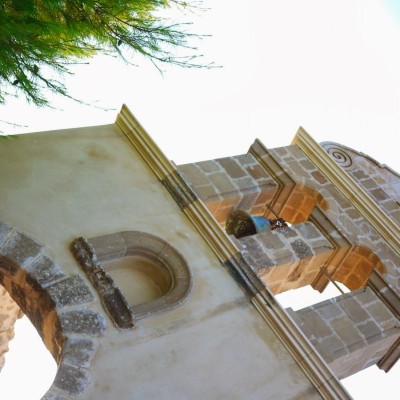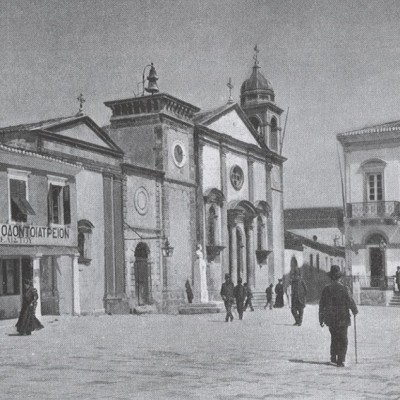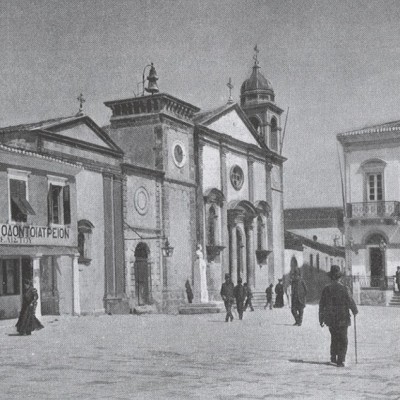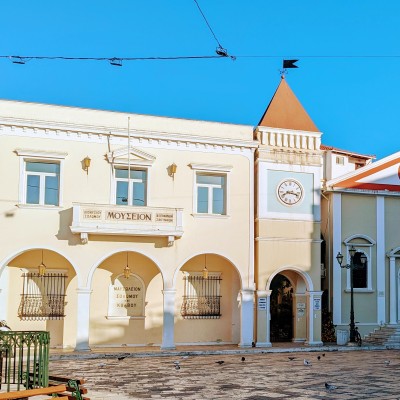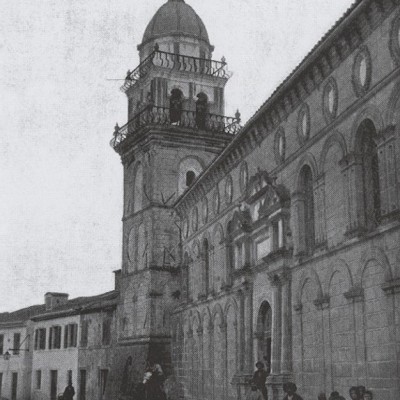Painting
Art in Zakynthos was a stimulating power and a genuine expression of the local tradition, but it also had many adventures, due to the devastating earthquakes. Most of the works of ecclesiastical art saved by the devastating earthquake and fire of 1953 are now in the Museum of Zakynthos, while in the Museum of Solomos and Eminent Zakynthians there are works of donation, mainly of ecclesiastical and secular painting. The new churches were decorated with all the works that survived through the ashes of the lost city. These works give us a complete idea of the course of painting and it is not an exaggeration to say that Zakynthos should be considered as "the artistic center of the Ionian island, not only because despite the frequent disasters from the earthquakes it still brings together the most numerous and characteristic works of the 18th and 19th century period, but also because it became the main base of particularly remarkable painters, such as Panagiotis and Nikolaos Doxaras, Nikolaos Koutouzis and Nikolaos Kantounis"[1]. In their works, facial expression becomes more realistic, movement becomes bolder, clothing becomes modern. Rigid and established movements are almost abandoned, style acquires grace and elegance. It is the so-called "Ionian" school of painting, a development of the "Cretan-Byzantine of the 16th and 17th centuries, which with the influence of Italian art, after so many centuries of Venetian rule, opened the window to the West, which generously gave it the great influence of Mannerism, Baroque and Flemish painting in the way of expression. The technique of tempera is abandoned and oil painting prevails, elements of secular art are introduced, strong emotions are expressed, new iconographic circles are introduced, while large paintings replace the frescoes in the temples. In secular painting, a new kind appears, portraiture, which continues its autonomous course, supported by the new technique of oil painting on canvas.
The younger generation of painters, Dimitrios Pelekasis and Christos Rouseas, tried with knowledge and sensitivity to proceed with the recording and maintenance of monuments and the depiction of the most important figures of Ionian island history so as not to be forgotten over time. Painters today, such as Eleni Gounari, Thalia Xenaki, Stefania Strouza open a dialogue with the past and try with their works to understand the new aspect of Ionian art, influenced by the past and utilizing the solid knowledge of today. Original digital exhibitions, such as the exhibition "Ionian Civilization: from Yesterday to Today" (https://past2future.gr/), by the Museum of Solomos & Eminent Zakynthians, support this statement.
Architecture
Architecture is the most affected form of art by the geomorphological changes from the natural disasters that took place over the course of the centuries.
The old town of Zakynthos, had the appearance of a Venetian city with its squares, kantounia, streets, the upper and lower Rouga Square, Strata Marina, with its tall and large houses, with its arcades and columns, with its sidewalks, with so many churches that were truly museums[2]. The morphological elements of mansions and churches have obvious influences from the Italian Renaissance and Baroque, but on a smaller scale, adapted to the environment of the island and maintaining "the Greek virtue of moderation"[3].
Regarding the architecture of the churches of Zakynthos, most, dating from the late 15th to the19th century, were built in the type of single-aisled basilica. The only example of a free cross with a dome is the katholikon of the monastery of Panagia Skopiotissa (1638). Examples of the three-aisled basilica are limited. A typical example of this type was the church of the Holy Trinity. One of the characteristic features of Zakynthos was the number of bell towers. Zakynthian "bell towers" belong to two major categories: the simple, with a high perforated wall and three high zones, usually constitute a continuation of a side of the temple and the tower-like ones, which are square floor towers with a trunk structured on floors, such as Faneromeni, Pikridiotissa, Agioi Pantes, Santa Maria delle Grazie. The trunk of others appears as a single element, such as Agia Triada, Agios Dionysios and Panagia Odigitria.
Today eclecticism has prevailed and the new city, built according to strict anti-seismic criteria, follows the architectural styles encountered throughout Greece. Except the columns, on the main shopping street, the Alexandros Roma (pre-seismic Rouga Square).
Music - Dance
One form of expression of the Zakynthian cultural heritage that derived "from the very soul of the Zakynthian people"[4], is Music. Other ways are the dances and songs of Zakynthos, which draw elements from the Byzantine tradition, but were also strongly influenced by the Turkish-occupied Greek area, Crete and Italy. The most influenced musical genres are the four-tone serenade, the two-tone serenade, the rural songs, the arekia and the ecclesiastical music[5]. The arekia, tetraphone, Zakynthian folk song, is undoubtedly a local exclusivity, a genuine creation and an expression of the folk muse, sometimes of poetry. A typical example is Yiannis Tsakasianos, who with the so representative for Zakynthos "Tsis Kyriaki to xypnima", managed to marry the famous poetry with the arekia.
Along with the folk music tradition, ecclesiastical music, which is established in the Ionian Sea as Cretan-Ionian and forms locally a purely Zakynthian style resembling the Byzantine one, from which it originates, but is chanted with western tetraphony. It is a music that dominates the heartfelt moments of the Zakynthians, culminating in the grand weekly melody: "Ina ti efryaxan ethni..." (a rough translation would be "For like wild unbridled horses they nations rioted..."), by the musician Ioannis Planyteros.
The atmosphere of the romance of 19th century Europe, find in Zakynthos their ideal component in the worship of the opera. Although the acceptance of the opera in Zakynthos was a compromise between the aristocracy and the rising Ionian bourgeoisie, eventually the people embraced it and supported it with all their strength. In this fertile climate, the Ionian composers participate generously in the musical cosmogony of the 19th century, with the leading and most important opera composer, Pavlos Carrer.
Nowadays, traditional bands, such as the Songwriters of Zakynthos, still keep alive the tradition of music that flourished on the island and with the performance of melodized poetry by great poets, they uniquely bring their speech to life. The modern generation, through the solid foundations given by the island's Conservatories, excels in all forms of musical expression in Greece and abroad. Typical representatives are tenor Dionysis Sourbis and musician Petros Klampanis.
Theatre
The relationship of the Ionian Islands in general, and of Zakynthos in particular, with the theatre is deeply rooted in time. Various scholars have emphasized the theatrical development and production of the Ionian island during the Venetian period, often comparing it to the Cretan literary flourishing of the same period.
Unfortunately, in the Ionian Islands we do not have much evidence of this flourishing, such as works saved, with the exception of Dimitrios Gouzelis' "Hassis" and Savoy Roumelis' "Comedy of Pseudo-Doctors" or Surmel. However, from other sources, such as various letters, we can certify the existence of remarkable theatrical works.
In addition, the "Omilies" (speeches) are known. What they are is outdoor, poetic and dramatic folk recitations made by ordinary people, mainly during the Carnival period for the revelry of friends[6]. At the same time, however, during the imitation of the Venetian rulers, the nobles of the Ionian Islands organized private performances of works, on the occasion of important events of their lives, such as weddings. Indeed, there is evidence that during the victories of the naval battle of Nafpaktos in 1571, the "Persians" of Aeschylus were played in a hall of the Headquarters in the Castle, in Italian translation, with young noblemen acting[7].
Children of this tradition are the creator of the first important work of the Modern Greek playwright Antonios Matesis, Elizabeth Moutsan – Martinegou, the first comedy writers of the Modern Greek theatre Socrates Zervos, Pios Martzokis and Ioannis Tsakasianos, as well as the father of the Modern Greek theatre Grigorios Xenopoulos, as well as Dionysios Romas. Offsprings of the same theatrical tradition are the thirty pioneering actors that Zakynthos gave to the Modern Greek theatre in the 19th century, best known by Dionysios Tavoularis.
Therefore, it should not come as a surprise that between 1750 and 1870, ten theatrical spaces had been created in Zakynthos. In 1750, the first theatrical building was erected in the town of the Castle. In 1836, began the construction of the theatrical space "Apollo" in Camilieri blueprints, while in 1872 the famous theatre "Foskolos" in Ernst Ziller blueprints.
Today's theatrical production is very intense, with theatrical ensembles that excel in the staging of theatrical works of local and international repertoire and cultural associations, which continue to present "omilies", on the platforms of the churches on the big festivals, in the city (Faneromeni, Agios Markos Square, Agios Loukas Square) and in the villages of Gaitani, Agios Dimitris, Ano Gerakario, Katastari and elsewhere. Contemporary creators are involved in the writing of “omilies” (Dionysis Yiatras, Stathis Piskopos, Antonis Mouzakis – Scarpas and many others).
Remarkable are the "Anemi" (Maria – Louisa Papadopoulou), the Ionian Theatre (Thodoris Kampitsis), the Curtain of Art (Babis Soulis), the Theatre Group Action Theater Team (Katerina Zoupanou) and the Theatre Tsi Zakynthos (Kostas Kapodistrias), at the "Avriakos" Garden Theatre. Also, the Zymosis Art Group (Konstantis Mouzakis), the Cultural Association "Erotokritos" of the village of Skoulikado, the Lithakia Folk Theatre Group "Kostas Skandalis", and the Zakynthos Theatre Stage of the village of Sarakinados, which created the homonymous Theatre. Participants in the “omilies”, which made history by Marinos Zivas and Tasis Mouzakis, and many others, while "Chrysomallousa", by Tony Lykouresis, in 1978, uniquely treasures the popular theatrical event "Omilia".
